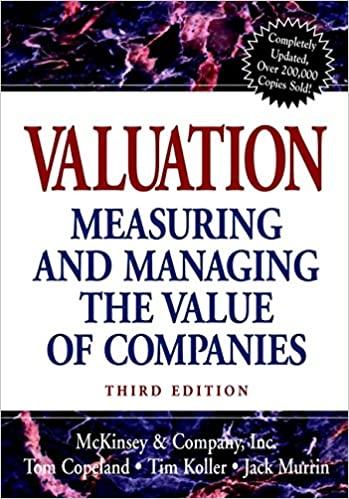Question
1) Use the following steps to find information about the relevant Caterpillar bond: Go to the Morning star bond center web morningstar Select Search and
1) Use the following steps to find information about the relevant Caterpillar bond: Go to the Morning star bond center web morningstar Select "Search" and then "Corporate"; Either type in "Caterpillar" as Issuer Name (this way of searching works relatively better), or type in "CAT" as Symbol/CUSIP (sometimes it may not work well though), then click "Show Results"; You shall see a lot of bonds with Caterpillar name tags showing up. As Caterpillar does have multiple issues of bonds outstanding, we, for simplicity purpose, just use its longest-maturity bond. So click for twice on "Maturity" (within the first row of the table) until the blue down arrow shows up, the Caterpillar bond list will be reorganized with the longest maturities on the top. You will see the longest CAT bond will mature at 03/01/2097. Click on the symbol of that specific bond, you will see even more details. Find and quote this bond's "Yield" or "Last Trade Yield" (either way, it means the bond's yield to maturity) as the proxy for CAT's longest-term "cost of debt capital before tax", i.e., Rd. 2) Use the CAPM approach, the DCF approach (or called dividend growth model DGM), and the own-bond-yield-plus-risk premium approach, respectively, to estimate CAT's cost of common equity stock capital. Then calculate the average of these three approach outcomes as Rce (or Rs, because common equity and stock mean the same thing). Hints: a) For the CAPM approach, we have already done so in Chapter 06 HW, so can just use our prior relevant HW answer; b) For the DCF approach, you can use CAT's most current share price as P0, "trailing dividend rate" amount (in "Statistics") as D0, and "Analysis" ==>"Growth Estimates"==>"Next 5 year (per annum)" amount as G; c) For own-bond-yield-plus-risk-premium approach, you can simply add a subjective 4% (i.e., the middle point between 3 and 5 percents) on top of Caterpillar's longest-maturity (in this case, 03/01/2097) bond yield. 3) For CAT's capital structure weights, we can go to Finance Yahoo and use CAT's "Statistics" to find "Market Cap (intraday)" for total common equity value E, to find "Total Debt (mrq)" for total debt value D, and then figure out the respective weights of equity and debt capital Wce and Wd. (The firm CAT doesn't have any preferred stock so far, so we do not need to concern about this part.) 4) Finally, use equation 10-10 (on the 12th edition) to compute CAT's WACC. (Note: Since the 2018 tax reform, all US federal corporate income tax rates have been reduced to 21% nationwide so far. Plus state corporate income taxes, currently the average level of federal-plus-state corporate tax burden is around 24%, fool/taxes
Step by Step Solution
There are 3 Steps involved in it
Step: 1

Get Instant Access to Expert-Tailored Solutions
See step-by-step solutions with expert insights and AI powered tools for academic success
Step: 2

Step: 3

Ace Your Homework with AI
Get the answers you need in no time with our AI-driven, step-by-step assistance
Get Started


